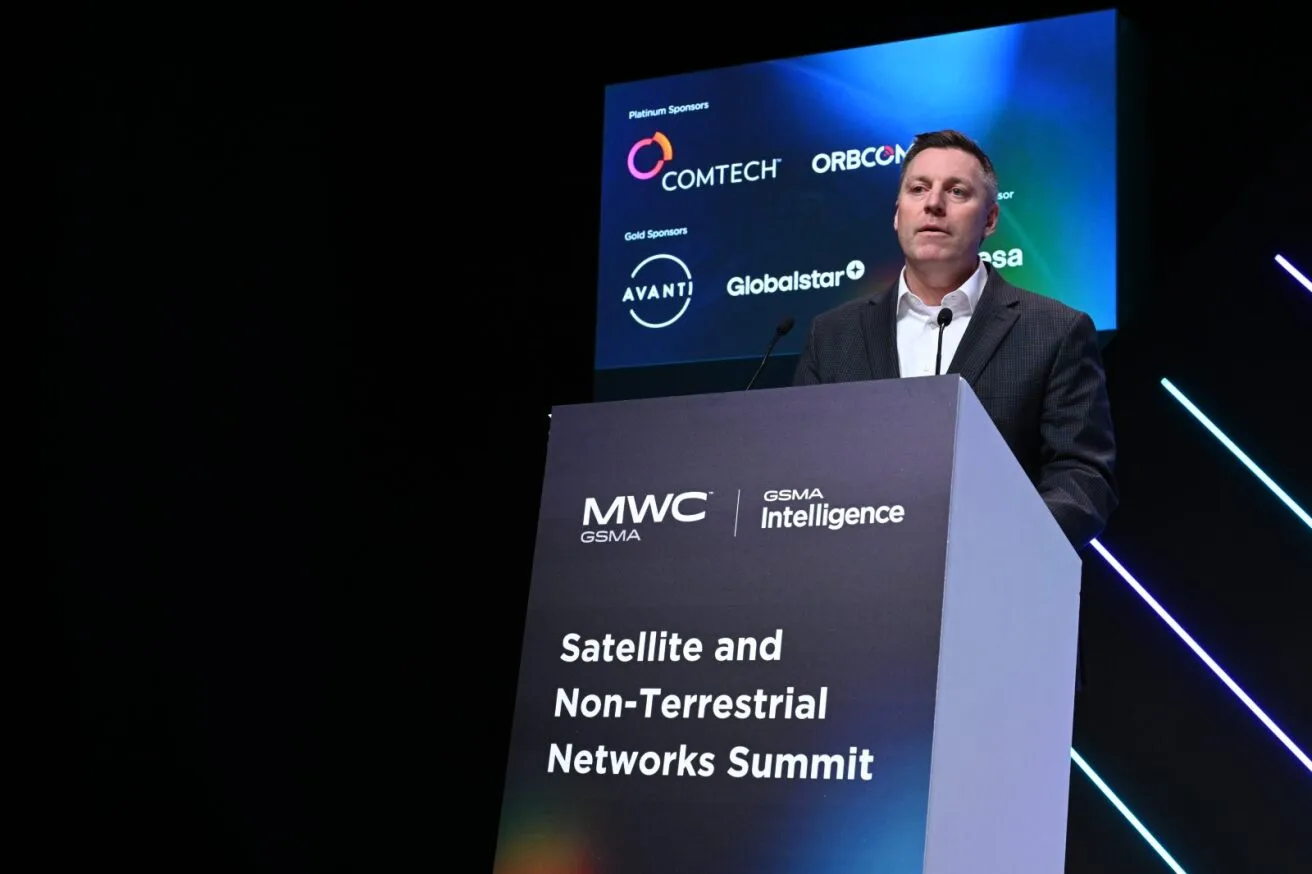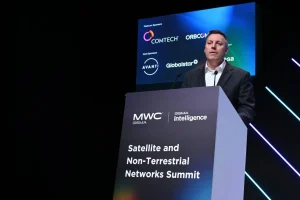
MWC 2024 keynote speech: the rise in satellite-cellular convergence
- Blog
- Value-Added Resellers
- MWC 2024 keynote speech: the rise in satellite-cellular convergence
While MWC 2024 is in the rearview mirror, there’s plenty of value to be taken from the three-day event in sunny Barcelona. Each panel discussion was unique in its own way but one key takeaway was this: the cellular and satellite space is heating up with new technological developments that are creating ample business opportunities.

During the Satellite and Non-Terrestrial Networks Summit, ORBCOMM CRO Fran Bogle’s keynote speech covered our IoT story, how satellite-cellular convergence is poised to change everything and what businesses should look for from an IoT connectivity partner. Missed MWC 2024? You can read Fran’s entire keynote speech below or watch the on-demand video.
We’re going to talk about convergence today. Listen, we’re going to give you a little bit of a spin from the industry that we’re in, the IoT space, where convergence is something that’s happening real-time with what we do. I know everybody in this room is waiting for the convergence of cellular networks with non-traditional networks. That’s what the summit’s about.
And that’s great. At ORBCOMM, we’re big believers in convergence. We’ve actually been selling converged satellite and cellular IoT solutions to our customer base for well over a decade. And we’re really excited about the opportunity. We think the opportunity is huge. We’ve built out our business to over two million subscribers and they’re spread out now amongst our satellite networks and over 500 cellular networks worldwide.
Now, what have we learned from those two million subscribers and from our customers? What we’ve learned is they really don’t care about the network. I know that’s probably hard for a lot of us in this room to hear. A lot of us in this room probably wake up every day thinking about networks, but they really don’t care.
Actually, there is one time they care: at the end of the month when they get their bill, then they care about the network. So I think we can all agree on that.
But really customers don’t care. They don’t care if their data transmits in the air, on the ground or under the sea as long as they are connected.
And at ORBCOMM, look, we have a front row seat to our IoT customers and our partners and their demand for data increasing, their demand for connectivity increasing every single day. And we hear from them the need for convergence and how it will influence their business operations. And what are the reasons behind that? It’s probably what you would expect. They’re looking for uninterrupted connectivity for their mission-critical data.
They’re looking to use cellular networks because they’re economical and widely available. What they want is the ability to be able to fall back to satellite when they’re out of cell coverage.
And finally, they want to be able to reach beyond the terrestrial network to reach some of the most remote places on Earth. So let’s talk about the opportunity.
I know the wireless providers here are working at this. We heard the panel talking earlier around 3G standards and the satellite players are jockeying for position to align their services to meet those standards and for their services to meet the wireless providers’ needs. The panel just talked about that. Look, convergence is a dream. The dream lives for us at ORBCOMM. But I want to share with you it’s not widely adopted yet.
I told you we’ve been selling some form of converged solutions to our customer base for over a decade, but it’s not widely adopted yet. It’s really an economical thing. But I don’t see that as a problem. I actually see that as an opportunity as we strive for the perfectly converged world. I’m going to tell you and show you examples of where our industry is going and why we’re super excited for the opportunities that convergence can bring to us.
And I’ll just call out that I think the opportunity is huge for everybody in this room. So who are we? Who is ORBCOMM? Okay, you could say we’re pioneers in the IoT space We’ve been in business for over 30 years, and we started 30 years ago with a constellation of low-Earth-orbit satellites. That constellation was the first approved exclusively for IoT. Back then, it wasn’t called IoT, it was actually called M2M or machine to machine communications, but that’s how long we’ve been in IoT: we were doing it before they called it IoT.
So how about that? Since then, we’ve launched a lot of satellites and we currently maintain a constellation, the only constellation that’s fully dedicated to IoT and the industry. Little bit of trivia about Orbcomm. Fun fact If you all remember when SpaceX launched and successfully landed a rocket back on earth for the first time in 2015, the payload on that rocket was actually some ORBCOMM satellites.
So that’s a fun fact about us. But as we evolved as a company, as we evolved in the IoT space, we saw a lot of opportunity in the transportation market. We went out and acquired some telematics providers and we established ourselves as an end-to-end and IoT provider.
In working in the in the telematics space, working with logistics customers, we also saw then the opportunity cellular IoT could provide for us. And at that point we went out and established partnerships with some tier-one wireless providers and we became an MVNO for cellular IoT. So we were hitting both sides of the fence here.
Well, as a satellite provider and a cellular provider for IoT solutions, we’ve evolved over the years. Again, we have over two million subscribers. We’re fortunate to have some of the biggest customers in our industry, and we’re really, really proud of that. Customers like Walmart, Caterpillar and Hapag Lloyd use our IoT solutions to monitor and manage their assets through better data.
That’s what we do and we’re really proud of that. Okay. So again, I’m obviously biased towards the IoT industry, but I do want to make a couple statements around data and how I think in all of our industries, customers consume data, you know, and a general statement I’ll make, I hope you agree, is that when you connect a customer to data, you give them access to data, the more data they will want.
So if I give an example from the consumer side, the average mobile subscriber, when the first iPhone came out, how much data did that average subscriber use versus today with the iPhone 15? How much data does that same subscriber use? Obviously, a massive amount more.
In the IoT space, an ORBCOMM example, when we first got into the telematics industry, we had a solution we sold to our transportation customers that enabled our customers to see their trucks.
At the time we thought it was gold. We thought it was the greatest thing in the industry, but we had to prove to our customers the ROI. We had to prove to them how the data can help them run and manage their operations better.
But once they deployed our solution and they saw their data rolling in, it was amazing what would happen.
We would start getting more and more questions from our customers. So it wasn’t just about monitoring the trucks. They would say, hey, can you help us see our refrigerated cargo? Could you help us see the temperature? And in real time, could you tell us if our driver is speeding? Could you tell us if our cargo reached its destination?
All questions wanting more data and helped us as a company evolve our solutions over time. You give customers data. They want more. You give customers words. They want pictures. You give them pictures. They want video. You give them video. They want 3D interactive video.
Again, we started out in the satellite space, evolved into the cellular IoT space, and your satellite really started it with a very simple use case. We were helping monitor and track large equipment, high-value equipment that was in very, very remote locations. On the cellular side, again, it was in logistics, trucking, supply chain. Those were the use cases and they were very divided for a long, long time.
Then some things happened on the satellite side. We started seeing things become not as complicated. We started seeing hardware actually shrink. We started seeing satellite transmissions become faster. We started seeing satellite plans become more economical. And then at ORBCOMM, we’re fortunate to have an awesome integration partner organization, and all our partners really have led us to where IoT is going in a lot of cases.
And we started seeing satellite use cases that will blow your mind. We had a partner that actually took fishing buoys, used satellite technology to turn them into smart tuna trackers. We had another partner that was using satellite technology to track wildlife, specifically elephants, in Africa.
And we saw another use case that that we kept seeing over and over and over again. There were the customers that were putting satellite technology on high-value cargo because they didn’t want to lose visibility of it. They didn’t want to risk any kind of theft or getting lost. We said to ourselves. Wow, that’s interesting. So we actually took that concept to a lot of our big transportation logistics customers and some of the biggest carriers in North America said, you know what, we are interested in being connected all the time.
So we actually got into the world of convergence with our transportation customers by selling them a companion satellite device to go with their cellular IoT device that we already had deployed. And that’s how we got into this world of convergence.
Now why are we so excited about it and where is it going today? The example I just gave you and I said to you earlier, it’s not widely adopted for an IoT customer to buy two devices from a company like me and have two service plans.
It’s expensive, right? And the economics of that probably inhibited our growth in what we call dual-mode or converged solutions. But fast forward to today, we’re really excited about our product roadmap, Our customers will have a choice to activate satellite, activate cellular or both: what we call dual-mode.
We think it’s a winner for this industry. We think that convergence in IoT and in the sectors we serve, a product like that will bring it to the mainstream. And we’re really, really excited about that.
All right. I know there’s challenges ahead for us all. And I do want to point out some things you should go ahead and look as you are evaluating partners.
Look, we’re a cellular provider. We’re a satellite provider. We’re an IoT provider, but we pride ourselves in being able to partner with whatever our customers need, whatever our partners need. But many of you, especially on the mobile side of things, are going to be evaluating potential satellite partnerships. And there’s a lot of new players in the space today, which is great.
But you’ve got to do your homework and you’ve got to make sure you’re looking out for speed bumps and you’ve got to find the right partner for you. There are a couple things I want to point out with us being in the satellite space for over 30 years, there’s some things that we know.
Take regulations. Number one, I think you heard that earlier in the panel as well. Look, I know in the cellular or mobile world regulation is something that you live and breathe every single day. But I want to assure you achieving regulation and compliance in the satellite space is ten times harder than the wireless world. So as you’re looking at a partner, you’ve got to make sure you completely understand their regulatory map, where they’re able to transmit and where they cannot.
And does that fit your needs? You just need to make sure you understand what their plans are and how fast they will get that regulatory approval that they need.
Number two is money. Space is expensive. Launching a satellite is expensive. But more than that, you know, the infrastructure to maintaining a satellite network is pretty significant.
Right? You look at an Earth station and the infrastructure that goes into that, you need to make sure your satellite partner has great financial backing, is in great financial standing, and can continue to grow and meet your needs.
The third is support. I know everyone here probably has some sort of customer support organization, but as you’re evaluating bringing on a potential satellite partner, who’s going to do the support?
Can your team do it or do you need help from your your satellite partner to service your customers? There’s no right or wrong answer in that. But as you’re evaluating a potential joint offering, you need to have a support model that you both feel good about.
Then finally, this is something that’s been huge for ORBCOMM. You know, we have great engineers at ORBCOMM, great satellite engineers, great hardware engineers.
You’re going to hear from one of them on the panel later today. And the hardware and our new designs are going to make an absolutely splash in the world for convergence in our space. But having a partner that can produce and provide hardware that meets your standards and helps you continue to innovate is very, very cool.
And finally look, we all have challenges. We’re all going to have challenges in the worlds of convergence. You know, we’re excited, but we know we’re each going to have our own challenges. But like anything in telecommunications, it requires standards and it requires cooperation. I hope what you heard from me today is that what we’re seeing in our industry has excited you as to what the opportunity could be.
We truly feel that if we can provide uninterrupted connectivity any time, any place, to our customer base, they will want more, they will want more and they will want mayor. I hope you can all agree to that.
Thank you so much for your time. Enjoy the rest of the Mobile World Congress.

Cody Lirette is Senior Content Marketing Manager at ORBCOMM. With over a decade of marketing and communications experience for both the public and private sector, he uses his passion for innovative technology and plain language to build compelling content that inspires action.
















